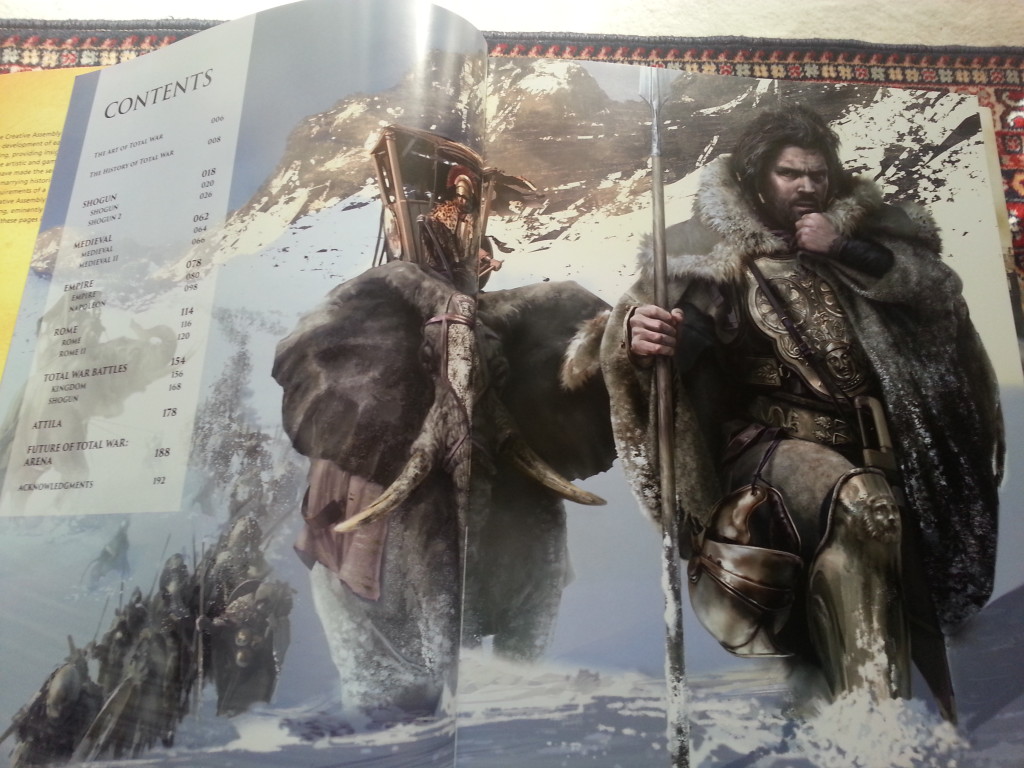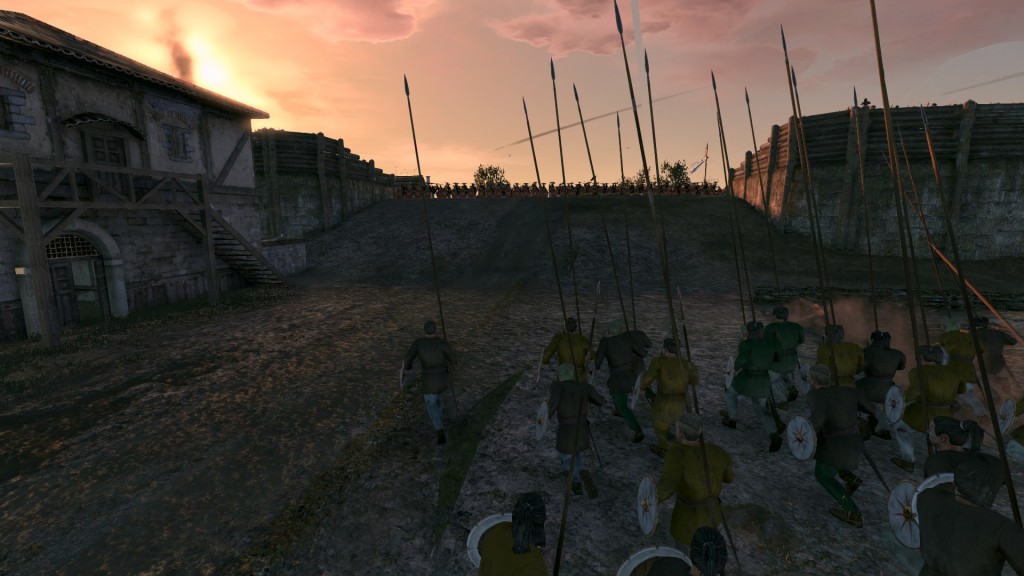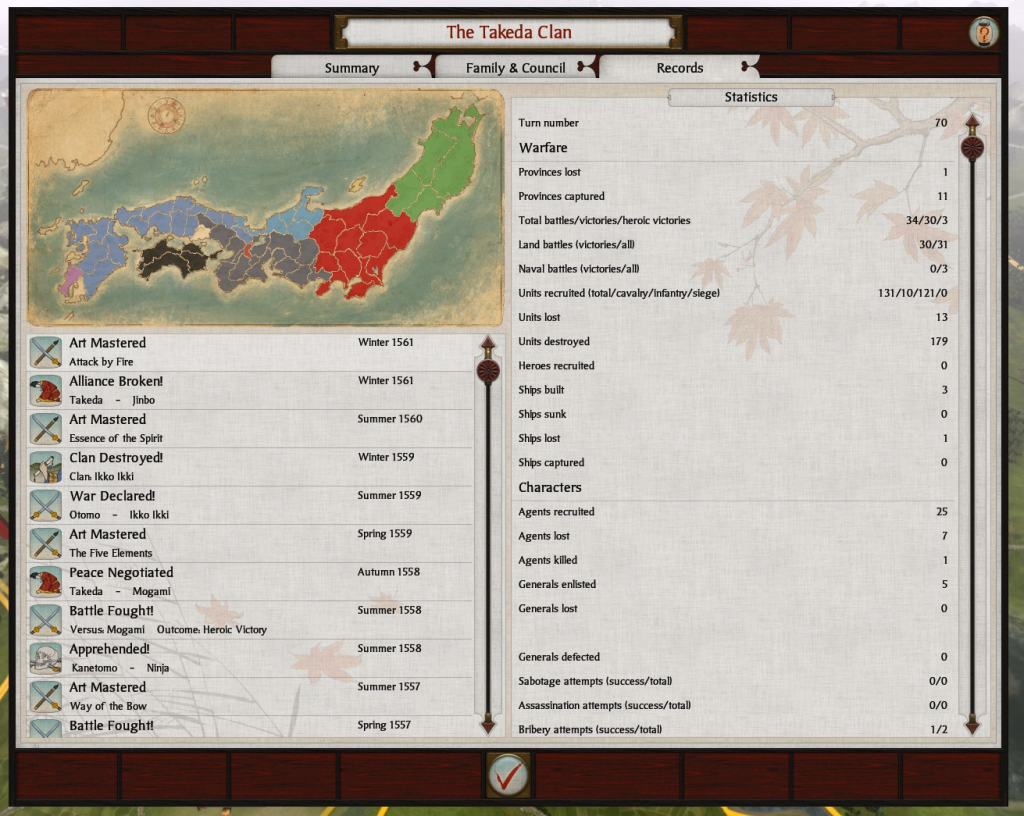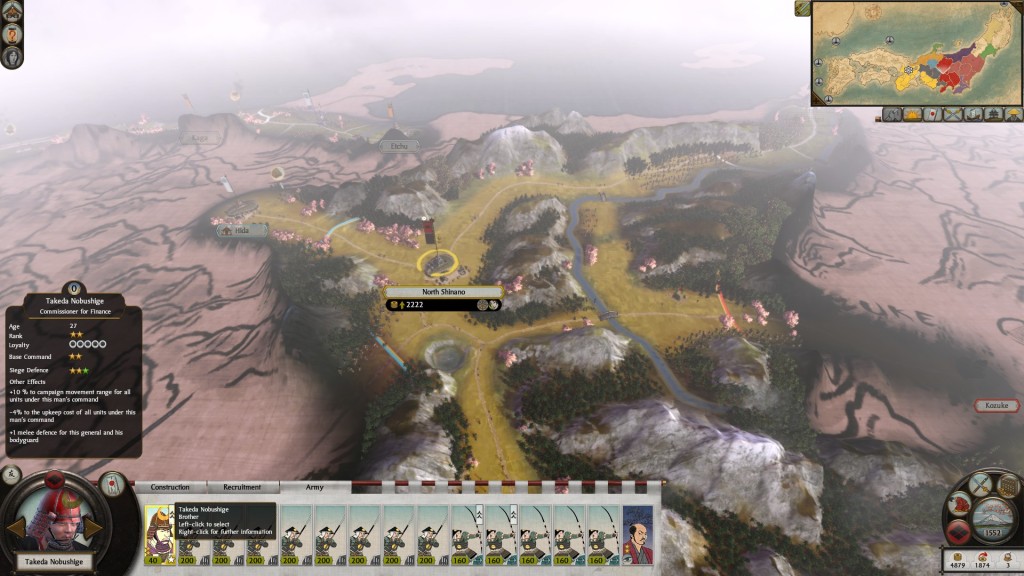Last Christmas, I spent some very pleasurable hours in the shoes of Alexios Komnenos, Emperor of Byzantium, trying to rebuild my battered empire. This week’s song, added as part of the “Songs of Byzantium” DLC for Crusader Kings II, formed part of that experience. Enjoy!
 Peter Sahui
Peter Sahui
Clippings
- A raft of previews have emerged about the new Mad Max game; USGamer’s is the most thoughtful.
- A fond retrospective of the original Mass Effect.
- Another Rob Zacny piece on TIE Fighter, and its depiction of imperialism.
Strategy Games and the Post-Apocalypse
Just as I associate post-apocalyptic video games with one franchise, Fallout, so I associate post-apocalyptic strategy with one game, Vic Davis’ Armageddon Empires. It’s an excellent game, whose design I dissected several few years ago. It’s also a unique game – both in the sense that it’s original, and in the sense that it’s the only “strategic level” post-apocalyptic game I can think of. Even adding a few strategy games that take place at smaller scales produces a very short list1.
- Fallout Tactics is a squad-based tactical RPG. Convoy is a new (and apparently flawed) indie game billed as FTL meets Mad Max. And if zombies count, Sarah Northway’s Rebuild was a Flash game that took place in the aftermath of a zombie invasion. ↩
Clippings
In the last few weeks, I’ve dipped into a variety of games, without spending much time on any one: Assassin’s Creed 4; Shadow of Mordor; Counterspy; Order of Battle: Pacific; Kerbal Space Program; and Castlevania: Dracula X Chronicles.
Mostly, I like them. AC4 is as enjoyable as ever. Kerbal captures the wonder of spaceflight when I see the horizon before me, and the terror when I try to get my Kerbonauts back down. After a few hours, I’m comfortable calling it one of the best science fiction games I’ve played. Mordor, Counterspy, and Order of Battle: Pacific, so far, live up to their strong reviews and word of mouth. (Or, in one case, live down – I agree with the consensus that OOB: Pacific‘s naval battles are the weakest part of an otherwise strong game.)
Dracula X is the odd one out. I had never played a Castlevania game before, and I wanted to see what the fuss was about. Unfortunately, I think I started with the wrong one. I am not good at platformers… and this is a difficult platformer with limited continues. After beating my head against the first two levels, I am about ready to download a saved game that will unlock the other included Castlevania release, the well-regarded Symphony of the Night.
In this week’s news:
- The Witcher 3 is out, to rave reviews. Pick your favourite gaming site, and odds are it’ll have a favourable review.
- Logic Artists has announced Expeditions: Viking, a sequel to Expeditions: Conquistador. This is great news! Conquistador was an original game in an original setting; I’d love to see what the developers do with Vikings.
- Firaxis has announced Rising Tide, an expansion for Civilization: Beyond Earth – here are interviews with PC Gamer and RPS. After being disappointed by Beyond Earth, I am reluctant to part with any more money…
Musical Monday: The Faction Themes of Endless Legend (composed by Flybyno)
I love Endless Legend‘s soundtrack, and I love its imaginative, distinct factions. This week, I thought I’d bring them together. Below, I highlight one theme from each of the three factions that I’ve played (there are eight factions total, each with two themes). Enjoy!
Guns of Icarus Online: Adventure Mode Follow-Up Q&A
Guns of Icarus Online is one of the most unique games I’ve played – a team-based dieselpunk airship game, in which rival crews try to shoot each other out of the sky. When it launched in 2012, it was strictly PvP. The following year, developer Muse Games launched a Kickstarter campaign to add PvE (“Adventure mode”), and it seems to be coming along nicely.
Read on for my follow-up email interview with Howard Tsao, CEO of Muse Games, about Adventure mode:
Peter Sahui: Hello, and welcome to the site!
When I last spoke to Muse Games in 2013, you were running a Kickstarter campaign for “Adventure mode” — a large expansion pack that would add PvE and co-op to the game. How is that coming along?
Howard Tsao: It’s been a long journey, with the scope of the expansion arguably larger than the original game, but we’re constantly making progress. Right now, in addition to iterating on some of the game modes and honing AI director as well as AI enemy movement and behaviour, we’re also doing work on player, faction, and world progressions. A lot of the in mission or in match feedback and progression are being designed and worked on as well. We’re creating factional airships, boss ships, and wardrobe as well, and we’ll soon move into designing more maps and game modes as well.
Clippings
This week’s biggest news item is a movie – Mad Max: Fury Road is out, to rave reviews. It deserves them. Fury Road is what Mad Max movies should be. It’s what Mad Max movies can be, given a reported US$150M budget. It’s thrilling, visually spectacular (sometimes downright beautiful), and features a tough, capable female lead – I can sum it up in one phrase: “Holy @*&%, that was cool!” If the upcoming Mad Max game can live up to the movie, it will be a blast.
In other news:
- There are plenty of upcoming space games; Rebel Galaxy‘s unique features are (1) a country music soundtrack and (2) that it gives players a capital ship instead of a fighter. Here is USGamer’s video preview; here are written previews.
- Brief but interesting – USGamer takes a look at genres that did better outside their home countries.
Clippings
- Hearts of Iron IV has been delayed again, with the new date to be announced after the team is done working on “a large milestone”.
- Still on the subject of WW2, reviewers are glowing about Order of Battle: Pacific, a new game inspired by Panzer General and Unity of Command.
- PC Gamer reviews Kerbal Space Program, version 1.0. The game has been available in pre-release form for ages — I wrote very briefly about it years ago — and so the PC Gamer piece reads more like an appreciation.
- In adventure game news, reviews are uninspiring for Broken Age: Act 2. I’d held off buying until the entire game was out. Perhaps I should keep holding out for a better discount?
- And finally, a game I never knew existed: A-Train 3D, a crunchy train management game for 3DS.
Musical Monday: “Travesuras De La Vida” (Tropico 4), by Alex Torres and his Latin Orchestra
Have I got a treat for you this week! The music of Tropico 4 is fantastic, both in its own right, and as a way to bring the setting to life. Enjoy – and check out artist Alex Torres’ other work. I’m listening to his catalogue on Spotify as I type…
Endless Legend & Age of Wonders 3: One Year On
The two expansions to Age of Wonders 3 have brought new races, a new character class, and (together with patches), assorted features and balance tweaks. They have also addressed my single biggest complaint with the game: the victory conditions (and their effect on pacing).
At launch, there was one way to win AoW3: destroy all opponents. This made the endgame a slog. Now, there are several other options:
- Beat down the AI players to the point where they surrender (added via patch). Per the developers, this is meant to happen after the “epic final battle… in situations where the AI is substantially outmatched and just lost a great number of its forces in a battle.” Based on the two AI players who surrendered after I crushed their multi-stack main armies, this works as promised!
- Territorial control, added in the first expansion. Similar to the Thrones mechanic in Dominions 4, this requires the player to take several “seals of power” defended by independent monsters, and hold them while progress towards victory ticks up. As the monsters periodically respawn, the seals have to be garrisoned – I suspect this is a risk/reward mechanic. Do you grab many seals, and risk spreading yourself too thin? Encouragingly, AI players do realise the importance of the seals; I lost my second game post-expansion when the AI flattened my armies and then captured the seals.
- A new, Wonder-style victory condition, added in the second expansion. I’m still getting a handle for this one; the developers describe it as “a great option for more defensive players”. Unlike the seals victory, aiming for this will provoke the AI players into declaring war, so it’s a defensive victory rather than a peaceful one.
Clippings
- My link of the week is this trailer for the upcoming Mad Max game, due out 4 September. It looks great! Let’s see if it lives up to that potential.
- USGamer previews Xenoblade Chronicles X, the upcoming Wii U sequel to Xenoblade. And here, Nintendo presents an hour of gameplay footage.
- Creative Assembly states that it will develop Total War: Warhammer in parallel to, not instead of, historical games.
What I’ve been reading
I wanted to go into a bit more detail on this week’s books – Night Soldiers, by Alan Furst (novel) and The Grace of Kings, by Ken Liu (novel).
Night Soldiers is billed as a spy novel. I say ‘billed as’ because it’s really a collection of vignettes, loosely linked by the 1930s-1940s world of espionage. Here, a Bulgarian lad comes of age as a trainee spy in Moscow, amidst the terror of Stalin’s purges. There, a lethargic American joins the OSS, parachutes into occupied France, and discovers his talent for sabotage. It’s a vivid, immersive read – although as with the novels of Patrick O’Brian, the emphasis is on atmosphere rather than plot, so it may not be to everyone’s taste. If you’re interested in the era, give the sample chapter a look.
The Grace of Kings is a much-hyped epic fantasy inspired by Chinese history. It’s interesting, both for its setting and its style. It also tells a pretty good yarn!
Grace of Kings is the story of two men, Kuni the trickster and Mata the warrior, as they rise to power. Their adventures are, essentially, a fantasy retelling of the fall of the Qin Dynasty and the rise of the Han. (Seriously, knowing a bit about the period was enough to let me guess where the plot would go. I even guessed how specific incidents would unfold.) The Chinese influence extends beyond the setting – the mythic tone, the occasionally detached prose, and the willingness to tell rather than show remind me of the pre-modern literary conventions of Three Kingdoms. My main complaint is that one or two character actions felt contrived, seemingly so as to stick to “history”. Overall, a recommended read for fans of epic fantasy novels and grand strategy games (and maybe even Konami’s Suikoden RPGs).
Finally, I read Terry Pratchett’s Maskerade (novel) – his parody of The Phantom of the Opera. Decent, amusing, with some pointed comments on superficial beauty. Recommended for Discworld fans.
A spiritual successor to KOEI’s Romance of the Three Kingdoms?
That is my initial impression of Oriental Empires (press release here), a newly announced 4X game that will be set in China between 1500 BC and 1500 AD. The bullet points and especially the screenshots remind me of Endless Legend/Civilization V meets Romance of the Three Kingdoms XI – it looks like all combat takes place on a hex-based strategic map, rather than being divided between a tactical and a strategic layer. The developers, R. T. Smith and John Carline, do have experience – both men have previously worked on the Total War series, with Smith’s experience stretching all the way back to the original Shogun. With the game scheduled for Early Access in ‘summer 2015’ (northern summer, I assume), the finished product is still some ways off.
Personally, I think the idea has potential. I’m always up for a novel setting, and China is badly underused in (Western) games. I’m trying to line up an interview with the developers, and will report back with any findings.
Musical Monday: “Restriction” (Tactics Ogre), composed by Hitoshi Sakimoto
Tactics Ogre might just have my single favourite soundtrack of any game. This week, I present the hero’s theme, appropriately heroic. Enjoy!
What I’ve been reading
- Catherine the Great: Portrait of a Woman, by Robert Massie (non-fiction). Finally finished after several months. Good book! Perhaps better in its first half, which deals with Catherine’s life before taking the throne — as the title suggests, the emphasis is definitely on Catherine the person rather than on Catherine the ruler. Recommended for fans of Europa Universalis 4.
- Iron Kingdom: The Rise & Downfall of Prussia, 1600-1947, by Christopher Clark (non-fiction). A dense political history comprising a chronological narrative (interesting) broken by the odd thematic chapter (rather dry). I’m about halfway through, and so far, so good.
- Sagittarius Rising, by Cecil Lewis (non-fiction). Another book I finished long after I began, this is the beautifully written memoir of a WW1 British fighter pilot, containing some beautifully poignant moments — at one point, the author recollects his mother making him sit for a new photo before he went off to war, so she’d have something to remember him by if he never came back. (Happily, the author lived on to a ripe old age; he wrote this book in the 1930s.) A brief coda deals with his post-war career trying to establish aviation in China.
- The Mechanical, by Ian Tregillis (fiction). Clockpunk fantasy set in a world where the Netherlands invented and enslaved clockwork robots, then used their new toys to dominate the world. It’s a dark, entertaining read; I think I preferred the author’s earlier Milkweed Triptych, but this is worth a look if the premise interests you.
- Wyrd Sisters, Witches Abroad, and Lords & Ladies, by Terry Pratchett (fiction). The delightful adventures of three witches: stern, practical Granny Weatherwax; bawdy old Nanny Ogg; and idealistic young Magrat, as they romp through skewed versions of fairy tales and Shakespeare. I’d rank these amongst Pratchett’s better novels, due to their humour (Witches Abroad is especially hilarious) and engaging cast. If I had to pick one, it would be Lords & Ladies, which is the best plotted and has my favourite “character moment” of the three. Highly recommended to fantasy fans!
Clippings
- With Bloodborne and Pillars of Eternity released to glowing reviews, it’s been a big week for RPG fans. My link of the week is this excellent interview with Hidetada Miyazaki, creator of Bloodborne and the Souls games. Did you know that it was Ico, of all games, that inspired him to become a game developer?
- A look behind the scenes at Paradox development (while the article contains some new screenshots of HOI4, its focus is on process rather than any individual game).
- I don’t think I’ll ever play Vietnam ’65; all the same, Rob Zacny and Tim Stone make it sound fascinating and unique.
Musical Monday: “Trisection” (Final Fantasy Tactics), composed by Hitoshi Sakimoto
I cannot believe that in almost three years of Musical Mondays (how time flies), I have never presented this song. It’s the first battle theme heard in Final Fantasy Tactics – arguably it’s the signature battle theme of FFT. Unfortunately, there has never been an orchestrated or remastered version of the FFT soundtrack; the song below is what you would hear in the original Playstation or PSP game. Enjoy!
The Roman Experience in Total War: Attila
After 100 turns, I threw in the towel on my attempt to save the Western Roman Empire. The legions, and my treasury, had finally reached their limit. The barbarians never stopped flooding in, from the north, east, and the hitherto quiet south. City after city had gone up in flames. The Roman Empire was dying by a thousand cuts, and there was no more point in slogging on.
I had a great time.
Thoughts on Cities: Skylines
My first city made as much sense as a noodle-bowl.
At one point, I went nuts building high-rise apartments without ensuring adequate road access. The result was a mess. Commuters clogged the roads. Fire engines, delivery vans, garbage trucks, and even hearses couldn’t get in. Burnt-out buildings, rubbish and dead bodies accumulated. I had to demolish much of that district and build it all over again.
I learned my lesson. Sterling Park, my new high-density district, would be a marvel of urban design. Before the first resident moved in, I ensured all my infrastructure was laid out. New subway lines connected Sterling Park to the rest of my city (and let residents move from one end of the district to the other). Parks and gardens provided green space. A new freight train ensured that the shops could receive goods. I even built a new university campus — my existing one was all the way at the far end of the map. The towers went up. The citizens moved in — and loved it. The land value shot up. I was delighted.
Clippings
- Sid Meier’s Starships is now out, and reviews are mixed. Apparently, it places a bit too much emphasis on the “light” part of “light strategy”; I will probably give it a miss.
- The developers of Endless Legend are planning a new free update, to be followed by an expansion pack in April.
- Another new expansion has been announced for Age of Wonders 3. It will add the Necromancer class and two new species, the Frostlings and the Tigrans,
Remembering Terry Pratchett, 1948-2015
I discovered Terry Pratchett when I was a teen.
I knew of him before then. I spent a lot of time in bookshops, haunting the fantasy & science fiction aisles, and the garish, glorious covers of his books stood out. I think I even played one of the spin-off adventure games. It wasn’t until The Last Hero, released in 2001, that I actually read one of his books. I’ve been a fan ever since.
Pratchett was very funny. I still laugh when I think about the unhygienic frying pan (containing one single nutrient, crying because it was all alone). As observed in many obituaries, he was also remarkably humane. Fantasy and science fiction are packed with unreasoning monsters — “always chaotic evil”, in the old parlance of Dungeons & Dragons. Not Pratchett. Everyone in his novels is a person: sometimes good, sometimes bad, sometimes bigoted or stupid, never mindless. Sometimes, Pratchett played this for laughs, as with vampires who’ve given up drinking human blood. Sometimes, it could underpin an entire story, as in the case of troll vs dwarf racism. And his talents extended beyond Discworld. Readers of this blog might be interested in Only You Can Save Mankind, a clever riff on Wing Commander (and video games more generally). What happens when the aliens decide they’ve had enough of being slaughtered by the player?
Individual Pratchett books were hit or miss. As a whole, his work was great. If asked to pick favourites, I would name two from Discworld: Guards! Guards! and Night Watch, written thirteen years apart. Both star the same character, veteran policeman Sam Vimes. When we meet Vimes in Guards, he’s a pathetic drunk, worn down by a thankless, dangerous career; amongst other things, Guards is the story of Vimes rediscovering his duty. Guards isn’t very deep, and it doesn’t delve into the serious themes that the later books do. It’s also, for me, the single funniest thing Pratchett has written, spoofing everything from secret societies to heroes who always win when the odds are a million to one. Night Watch, in which an older, tougher Vimes finds himself caught up in a revolution, is a different beast — topical, in light of the last few years, and far more serious. The Vimes of Night Watch wears a lilac to commemorate fallen friends; I thought it would be appropriate to use a picture of a lilac to accompany this post.
We are the poorer for Pratchett’s death. I find myself thinking of his take on the afterlife, and specifically, what happens (spoiler warning) to an old schoolteacher who tags along with a group of ageing barbarians. The deceased barbarians can look forward to Valhalla, the teacher knows, but he’s rather surprised when after dying a hero’s death, the Valkyries carry him away to the barbarians’ afterlife. I’m sure the Muses themselves would have showed up for Pratchett.
RIP, Sir Terry. By now, I bet you have the Muses crying with laughter.
Musical Monday: “Swanky Maximino” (Grim Fandango), composed by Peter McConnell
This week’s song is another of my favourites from Grim Fandango. It’s possible to miss it entirely — it plays in one teensy, tiny, optional room — and that would be a shame. It’s so great that I lingered to listen. Enjoy!
Note: I’ve decided to change the format again – the site’s been lagging, and I suspect this because there are too many videos on the front page. Click through for the video.
Clippings
This has been a great few weeks for strategy gaming; we’ve seen the launch of Total War: Attila (very good) and Homeworld: Remastered (on my ‘to play’ list), and Cities: Skylines and Sid Meier’s Starships are imminent. I’ve been playing a review copy of Skylines, so keep an eye out for my thoughts.
In this week’s links:
- Here is a great Hearts of Iron IV preview from Rob Zacny at PCGamesN.
- Oreshika, a Vita RPG high on my watch list, has released to generally positive reviews. Its premise is unique and intriguing – you command a clan with fixed lifespans. They’re born, they adventure, they gain experience, they die, they pass their abilities and heirloom items onto their kids. This sounds about as close as JRPGs will get to XCOM (and Training Roulette) – I plan to pick this up.
- Still on the subject of JRPGs, here is a retrospective of Tri-Ace — the studio that developed one of my favourite series, Valkyrie Profile. Now that Tri-Ace has been acquired by a mobile games developer, I guess I can finally bury my dreams of Valkyrie Profile 3
- A love letter to Grim Fandango‘s Rubacava (spoiler warning).
What I’ve been reading
- An Elephant for Aristotle, by L Sprague de Camp (novel) A troop of horsemen from Alexander the Great’s army transport an elephant from India back to Greece. Unfortunately, this is one more historical novel whose premise is better than its execution. A long way from the author’s best book; it could really have done with the humour and charm that characterise his speculative fiction.
- Girl Genius (webcomic) – For the last couple of weeks, I’ve binged on this long-running “gaslamp fantasy”, whose heroes inhabit a world where seemingly every mad scientist trope is true (at one point, two characters agree that the best way to cure a third is to kill him… and then bring him back to life); the heroine herself is the heir to the maddest, baddest scientists there were. GG is colourful, imaginative, and often funny. It also labours under the weight of a rambling plot, with a new complication or cliffhanger every few pages. I suspect part of the problem is that GG is an ongoing, serialised work, and hence not constrained by the need for concision! Still, worth a look for speculative fiction fans.
Only a Flesh Wound! Total War: Attila impressions
War has come to Rome.
Lands that were Roman for centuries are now desolate or in enemy hands. Northern Spain and the tip of Italy are smoking rubble. The empire’s leading general, Stilicho, is dead with all his army — though they managed to take Alaric, King of the Visigoths, with them. While the legions can notch up the odd victory, the stream of enemies seems endless.
And yet, all is not lost. Sacrificing the frontier bought me fifteen or twenty turns to pour every coin into rebuilding the Empire’s economy — its farms, cities, and waterworks. When a legion is mauled, I can afford to raise a new one; I think I can replenish my ranks faster than the barbarians can replenish theirs. Let us see who lasts longer.
29 turns into the game, the Western Roman Empire is battered, bleeding — and so far, unbroken.
Welcome to Total War: Attila. I expected a tough, fair challenge, and so far, it’s delivered. The Western Empire begins in crisis — its treasury is bleeding, its people are restive, and it’s surrounded by enemies. I’m still surrounded by enemies… but I’ve staunched the bleeding. With the right strategy and a bit of luck, I can see how I might be able to dig myself out. And I think that by avoiding mistakes, I could have done better still.
As this suggests, Attila is much better than its predecessor Rome 2 was at launch. So far, I have suffered one crash; annoyingly, this came right after I won a battle. Other than that, Attila seems polished and stable. The AI is shrewd and aggressive — perhaps a little too aggressive. Multiple AI factions have ignored nearer prey in favour of dogpiling me; I’m trying to defend Spain against three stacks that sailed all the way from the British Isles!
At this stage, I’d say Attila is very good. The caveat is that I’ve only experienced the early game, and only tried a single faction – the Western Empire. If the rest of the game lives up to the start, I think it’ll be one of the stronger entries in the series.
Appendix: starting tips
At the start of the game, the Western Empire has too few legions and too much frontier to defend. As such, the standard opening seems to beabandoning swathes of the Empire and falling back — sometimes all the way to Italy.
My strategy was somewhat less extreme. I pulled back to the shores of the Mediterranean – Spain, Italy, and southern Gaul. (I did not raze entire settlements behind me, as that increases unrest. I just demolished buildings instead.) Putting every penny into the economy seems to be key; otherwise the funds just will not exist to support a military buildup. If necessary, demolish buildings that cost upkeep.
With hindsight, I think I was a bit too hasty to fall back. What I should have done was combine several of the understrength Roman armies, then squash my smaller enemies early on, before they could join forces. That would solve my current problem — too many enemies! It would also be less gamey, and make it more feasible to hold the original frontier.
Whatever you choose, good luck, Imperator.
Let’s reunify Japan in Total War: Shogun 2! Part 3 (Final): Ride Forth Victoriously
Welcome to the final instalment of my Let’s Play of Shogun 2.
Previously, I stood on the verge of Shogun 2’s endgame — “realm divide”, in which most of Japan joins forces to stop the player. My armies were ready. My treasury was bursting. And so, I resumed the offensive after a long period of peace. Here is the situation, shortly before the end of Part 2:
In the east, my armies had just won their first victory against the Hatekayama clan (green). In the west, I was at peace; I shared my border with an allied clan, the Imagawa (grey), and a former ally, the Jinbo (light blue). Further west, past the Jinbo and Imagawa, was the single largest computer player: the Otomo clan (blue, also my ally).
Once I resume the game, Takeda Shingen and his son Nobushige lead my eastern armies against the Hatekeyama’s remaining force.
Musical Monday: “Bone Wagon” (Grim Fandango), composed by Peter McConnell
In honour of the Grim Fandango re-release, I present one of my favourite tracks from the original. Enjoy!
Inside The Art of Total War
As promised, here are photos I took of The Art of Total War.
Here is the table of contents. The book focuses on three branches of the Total War family — Shogun 1 & 2, Empire & Napoleon, and Rome 1 & 2. There is less on Medieval & Medieval 2, and less still, a bare few pages, on Attila and the spin-offs (Battles, Arena).
 The art itself ranges from unit sketches to concept paintings, and even some of the original maps that the developers used as inspiration. Read on:
The art itself ranges from unit sketches to concept paintings, and even some of the original maps that the developers used as inspiration. Read on:
Clippings
After the disappointment of Beyond Earth, early videos of Sid Meier’s Starships are a bit more encouraging. Start with this overview (skip to about 33 minutes in):
Then watch this video (complete with Sid in Starfleet cosplay) for a more in-depth look at gameplay:
This preview contains a bit more information.
In other news:
- Still in space, here is a preview of Homeworld Remastered.
- Not having an N64, I missed The Legend of Zelda: Majora’s Mask when it first came out. This review of the new 3DS version doubles as a retrospective.
- USGamer lists the essential last-generation console RPGs. It’s a good list, with the proviso that it excludes portable games — my one addition would be The Last Story (for Wii; my writeup here). Including portables, I would add several excellent PSP games — Tactics Ogre, Valkyrie Profile: Lenneth, and Final Fantasy Tactics: The War of the Lions.
- Previews (PCGamesN, RPS)are popping up for Act of Aggression, the upcoming RTS from Wargame developer Eugen Systems.
- A retrospective of Deus Ex: Human Revolution. My take would be: disappointing narrative, great aesthetic, great fodder for a Ghost in the Shell fan, very good overall experience. I even enjoyed the boss battles!
- The real XCOM underground base?
Let’s reunify Japan in Total War: Shogun 2! Part 2: Patience and Preparation
Welcome back to my Let’s Play of Shogun 2.
When we left off, my Takeda clan controlled a modest slice of Japan, to the north and west of modern Tokyo. To the east were my enemies: the Satake and Satomi clans. Further north were my old foes, the Uesugi clan; an uneasy peace prevailed between us, ever since I crushed their last invasion attempt.
My previous victory against the Satomi in Part 1 gave me a window of opportunity. and so, my first order of business is to march east. Takeda Shingen, lord of the clan, is off on another frontier. Command falls to his two brothers: Takeda Nobushige in the north, leading his army out of North Shinano province, and Takeda Nobukado in the south, crossing the river from Musashi.





